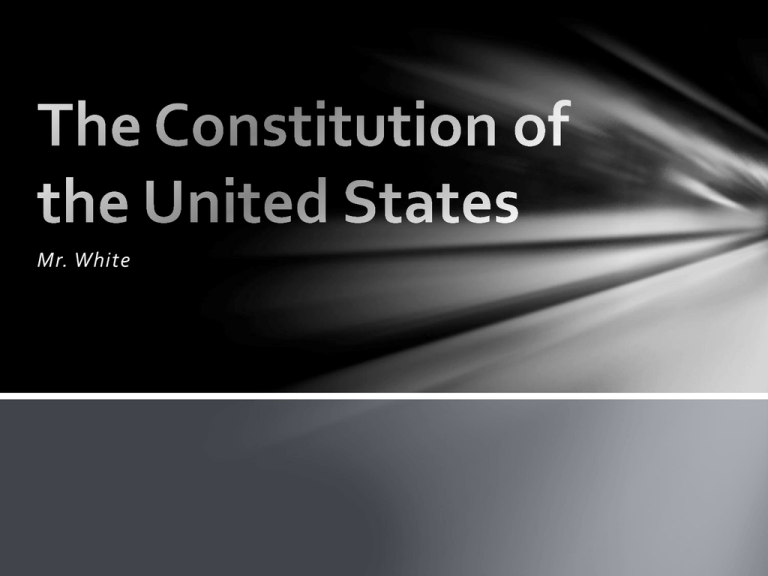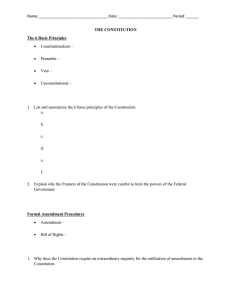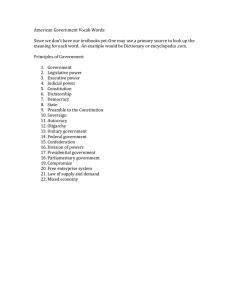
Mr. White
Intro to Political Sci. – 2/23/15
• Objective: SWBAT describe the structure of the Constitution.
• Agenda:
•
•
•
•
•
New Seats
Turn in Political Ideology Essay
Pass out Guided Reading Homework Packet
Structure of the Constitution Notes
Democracy School Survey
Upcoming Dates:
•
•
•
•
Wednesday – We will be in Room 251 for KeyTrain (last day!)
Thursday – Bring 28 Index Cards for your next Project
Monday, Feb. 27 - Ch. 3.1-4.1 Guided Reading Worksheet
Friday, March 6 – Ch. 4.1 & 4. Guided Reading Worksheet
The Constitution: Important Dates
• Written in 1787
• Signed on Sept. 17, 1787
• Ratification took place
between 1787-1790
• Delaware 1st
• Rhode Island last
• Took effect in 1789
Supreme Law of the Land
The Constitution is the
United States’
fundamental law.
It is “the supreme law of
the land.”
Key Facts About the Constitution
•
Purposes:
• Lays out basic framework and
procedures of our government
• Sets the limits within which government
must conduct itself
•
Length: 7,000 words (can be read in 30
minutes)
•
Strengths:
• Deals with matter of principle
• Is not weighed down with detailed
provisions
• Is organized in a simple, straightforward
way
Think about any paper that you have written for
an English class. What was contained in your first
paragraph?
What was the purpose of having your paper begin
with an introduction?
The Introduction of the Constitution
The Constitution has an
introduction. It is known as
the Preamble.
The Preamble serves as in
introduction and also sets
out the purposes and goals
of the government.
The Preamble
“We the People of the United States, in
Order to form a more perfect Union, establish
Justice, insure domestic Tranquility, provide for
the common defence, promote the general
Welfare, and secure the Blessings of Liberty to
ourselves and our Posterity, do ordain and
establish this Constitution for the United States
of America.”
Purposes of Govt. According to
Preamble
The Articles
Following the Preamble,
the Constitution is divided
into seven numbered
sections called articles.
These articles explain
various components of
the government.
The Articles
Article I: Sets up Congress
and explains its expressed
powers (Legislative Branch).
The Articles
Article II: Sets up the
presidency and explains the
President’s powers
(Executive Branch).
The Articles
Article III: Sets up the
federal court system
(Judicial Branch).
Article IV: Explains the
relationship between the
States and the federal
government.
Article V: Explains how
formal amendments can be
added to the Constitution.
The Articles
Article VI: Declares that the
Constitution is the supreme
law of the land.
• “Supremacy Clause”
Article VII: Explains how the
Constitution may be
ratified.
The Amendments
The articles of the
Constitution are followed by
the 27 formal amendments.
They are printed in the order
that they were adopted.
The Bill of Rights
The first ten amendments
are known as the Bill of
Rights.
Adding a Bill of Rights to the
Constitution was the only
way to get Anti-Federalists
to support the Constitution’s
ratification.
The United States
1789: small agricultural
nation with less than 4
million people spread
across the eastern seaboard
Today: world leader with
over 300 million people
spread from coast to coast
The Constitution of
today is and is not the
document of 1787.
Words have been
changed, added, or
eliminated.
Meanings of
words/phrases have
changed as well.
The Framers knew that
the Constitution would
need to be modified in
the future.
Formal Amendment
Informal Means
Amendment: a change
in, or addition to, a
Constitution or law
Formal Amendment:
Changes or additions
that become part of the
written language of the
Constitution itself.
There are four ways to
formally amend the
Constitution.
Know the chart!
All 27 amendments have been proposed by 2/3 of
Congress – never by a National Convention
26 Amendments were ratified by ¾ State
Legislatures
Only 21st Amendment was ratified by ¾ of States
conventions
The President has no formal role to play in the
amendment process.
So, proposing an amendment takes place at a national
level, but ratification takes place on a State-by-State
basis….
…which TWO Basic Principles of the Constitution could
this represent?
One restriction on Amendments:
The Constitution cannot be amended to deprive a state of its
territory or to deprive any state of its equal representation in
the Senate.
15,000 joint resolutions proposing an amendment have
been proposed to Congress since 1789
Only 33 have been sent to the States for ratification
Only 27 have been approved
There are five other ways to change the Constitution
without changing its written words.
Passage of basic legislation by Congress
Actions taken by the President
Key decisions of the Supreme Court
Activities of political parties
Reform/Custom
Congress has changed
the Constitution in two
ways:
Passed laws to spell out
Constitutional
provisions (flesh to the
bones of the
Constitution)
The way that Congress
has used its power
(added to it)
The ways Presidents have
used their power has also
contributed to the
growth of the
Constitution.
War Making Powers
Executive Agreements
The courts interpret the
law. How they do so
changes how we view the
Constitution.
Marbury v. Madison
There is no mention of
political parties in the
Constitution.
Parties have grown
immensely important
over time.
Conventions
Nominations
Appointments
Certain unwritten rules
have been followed over
time.
President’s Cabinet
Succession to the
Presidency
“no third term tradition”
Yes, There Is a Bill of Rights rap.
http://www.youtube.com/watch?v=tlt6R1
KD4E0
Ok, so maybe it’s not Magna Carta / Holy
Grail, but it took some serious swag to do
what the Founders did….
The Amendments
1.
Freedom of speech, religion, press, petition & assembly
2.
Right to bear arms
3.
No quartering of troops
4.
Searches & seizures
5.
Due process, double jeopardy, eminent domain
6.
Speedy, public trial by jury and right to attorney
7.
Trial by jury in cases over $20
8.
No cruel or unusual punishment or excessive bail and fines
9.
Un-enumerated rights reserved for the people
10.
Powers not listed reserved for the states
The Amendments
11.
State cannot be sued by a citizen of another state, its own state or a
foreign country
12.
Electoral College fixes (VP and Pres. Voting)
13.
Abolishes slavery
14.
Rights and equal protection of all citizens
15.
Right to vote cannot be denied based on race, color, or previous
servitude
16.
Income tax
17.
Popular election of Senators
18.
Prohibition of liquor
19.
Women’s Suffrage
The Amendments
20.
Terms of President (inauguration date)
21.
Repeals 18th Amendment
22.
Two term limit of President (up to 10 years)
23.
Presidential Electors for District of Columbia
24.
Right to vote in federal elections without a tax payment (no poll tax)
25.
Presidential line of succession
26.
Voting age dropped to 18
27.
Congressional pay increases






